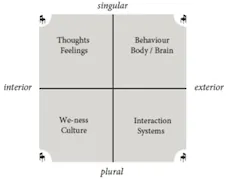Quote from Phil Brownell's review:
"The authors do an excellent job of exploring some of the issues inherent in field theory as it is resident in gestalt therapy. I appreciate the way they developed it, which seems intelligent, comprehensive, and logically friendly. Field theory is not especially “easy” to understand, but they have made it intelligible".
"Integrative Gestalt Practice - transforming our ways of working with people", by Mikael Sonne & Jan Tønnesvang .
‘A very important but nowadays too-often overlooked psychotherapy system interpreted using a cutting-edge integrative model, with novel and important results. Highly recommended!’
— Ken Wilber , author of The Integral Vision
‘This book lights up gestalt therapy with its insightful perspective, and integrates a wide range of human experience with the practicality of therapeutic techniques.’
— Erving Polster , author of Beyond Therapy
Integrative Gestalt practice: transforming our ways of working with people . Mikael Sonne and Jan Tønnesvang, Karnac, 2015, 240pp, £25.99, isbn 978-178220251
-
Reviewed by Charles Gordon-Graham
-
Both authors, based in Aarhus in Denmark, are pioneers and trainers in integrative Gestalt practice (IGP). This book is a very comprehensive account of IGP, which brings to the Gestalt approach a four-quadrant perspective from Ken Wilber’s integral model. The Gestalt process is framed within a set of four quadrants that embrace inner experience and outer observables, the individual and the collective. In this way IGP ensures that the practitioner always considers the holistic character of the Gestalt field. Sonne and Tønnesvang emphasise the word ‘practice’ in order to highlight that, although Gestalt is an approach in psychotherapy, it is also applicable in areas such as supervision, coaching, organisations and politics.
A criticism sometimes levelled at Gestalt therapy literature is that it can be theory-light; however, this book is very thorough in its treatment of theory; indeed, sometimes in the first chapters the book can feel a little heavy going because there is much to take in.
The first three chapters focus on different elements of Gestalt theory: namely the field, organism and Gestalt process. The fourth is concerned with contact, awareness and the experiment. There follows the long fifth chapter on interventions, which includes some example dialogues and discusses IGP in organisations as well as with individuals. The sixth chapter draws it all together, and is followed by useful appendices on IGP awareness and training exercises and on methodological pluralism.
Sonne and Tønnesvang also discuss IGP in relation to other theoretical modalities – for example, acceptance and commitment therapy (ACT) and coherence therapy – and they effectively identify Gestalt awareness exercises with mindfulness (itself a core component of ACT and some other modalities). One area not covered in the book is an IGP approach to dream work, which might be an intriguing area to explore.
An attractive feature of the book is the definition and reflection boxes, which are well integrated into the text, as are the figures, examples and exercises. Overall, I found this a well-written and highly coherent and comprehensive account of IGP.
Charles Gordon-Graham is a lecturer, counsellor, psychotherapist, poet and writer
- See more at: http://www.therapytoday.net
Quote from Birgit Erichsen's review
"It is a strong and bold move to start the development of integrative gestalt practice from scratch, as old building blocks are recombined to form a new pattern. The subject field of practice has been broadened, as essentially the same non- pathologizing/non-reifying practice is applied to individuals, groups/families and organizations".
